
A grenadier was originally a specialist soldier who threw hand grenades in battle. The distinct combat function of the grenadier was established in the mid-17th century, when grenadiers were recruited from among the strongest and largest soldiers. By the 18th century, the grenadier dedicated to throwing hand grenades had become a less necessary specialist, yet in battle, the grenadiers were the physically robust soldiers who led assaults, such as storming fortifications in the course of siege warfare.

The Somerset Light Infantry (Prince Albert's) was a light infantry regiment of the British Army, which served under various titles from 1685 to 1959. In 1959, the regiment was amalgamated with the Duke of Cornwall's Light Infantry to form the Somerset and Cornwall Light Infantry which was again amalgamated, in 1968, with the King's Own Yorkshire Light Infantry, the King's Shropshire Light Infantry and the Durham Light Infantry to form The Light Infantry. In 2007, however, The Light Infantry was amalgamated further with the Devonshire and Dorset Regiment, the Royal Gloucestershire, Berkshire and Wiltshire Regiment and the Royal Green Jackets to form The Rifles.

The Buffs (Royal East Kent Regiment), formerly the 3rd Regiment of Foot, was a line infantry regiment of the British Army traditionally raised in the English county of Kent and garrisoned at Canterbury. It had a history dating back to 1572 and was one of the oldest regiments in the British Army, being third in order of precedence (ranked as the 3rd Regiment of the line). The regiment provided distinguished service over a period of almost four hundred years accumulating one hundred and sixteen battle honours. In 1881, under the Childers Reforms, it was known as the Buffs (East Kent Regiment) and later, on 3 June 1935, was renamed the Buffs (Royal East Kent Regiment).
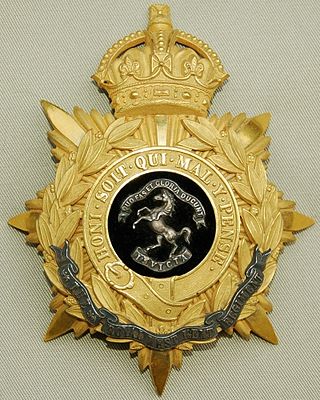
The Queen's Own Royal West Kent Regiment was a line infantry regiment of the British Army based in the county of Kent in existence from 1881 to 1961. The regiment was created on 1 July 1881 as part of the Childers Reforms, originally as the Queen's Own (Royal West Kent Regiment), by the amalgamation of the 50th (Queen's Own) Regiment of Foot and the 97th (The Earl of Ulster's) Regiment of Foot. In January 1921, the regiment was renamed the Royal West Kent Regiment (Queen's Own) and, in April of the same year, was again renamed, this time as the Queen's Own Royal West Kent Regiment.
The Light Division was a light infantry division of the British Army. Its origins lay in "Light Companies" formed during the late 18th century, to move at speed over inhospitable terrain and protect a main force with skirmishing tactics. These units took advantage of then-new technology in the form of rifles, which allowed it to emphasise marksmanship, and were aimed primarily at disrupting and harassing enemy forces, in skirmishes before the main forces clashed.
The Childers Reforms of 1881 reorganised the infantry regiments of the British Army. The reforms were done by Secretary of State for War Hugh Childers during 1881, and were a continuation of the earlier Cardwell Reforms.
The 83rd Regiment of Foot was a British infantry regiment that served in the American Revolutionary War. It was created in 1778 and disbanded in 1783, shortly after the war ended.
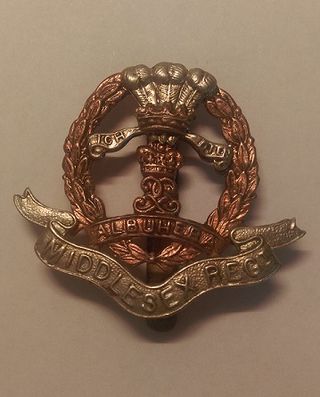
The Middlesex Regiment (Duke of Cambridge's Own) was a line infantry regiment of the British Army in existence from 1881 until 1966. The regiment was formed, as the Duke of Cambridge's Own (Middlesex Regiment), in 1881 as part of the Childers Reforms when the 57th (West Middlesex) and 77th (East Middlesex) Regiments of Foot were amalgamated with the county's militia and rifle volunteer units.
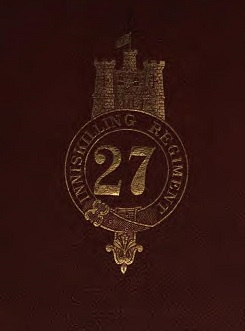
The 27th (Inniskilling) Regiment of Foot was an Irish infantry regiment of the British Army, formed in 1689. Under the Childers Reforms it amalgamated with the 108th Regiment of Foot to form the Royal Inniskilling Fusiliers in 1881.
The 130th Regiment of Foot was an infantry regiment of the British Army, created in 1794. After being raised it was sent to the West Indies, where it suffered heavy losses from tropical disease. The unit was disbanded at Santo Domingo in 1796, with the survivors drafted into other regiments.
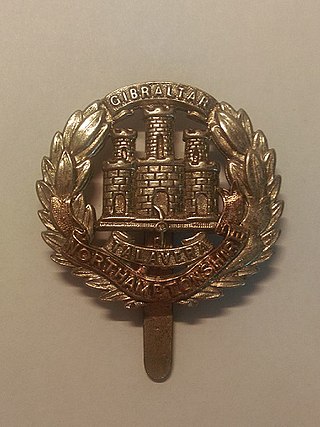
The Northamptonshire Regiment was a line infantry regiment of the British Army in existence from 1881 until 1960. In 1960, it was amalgamated with the Royal Lincolnshire Regiment to form the 2nd East Anglian Regiment, which was amalgamated with the 1st East Anglian Regiment, the 3rd East Anglian Regiment and the Royal Leicestershire Regiment to form the present Royal Anglian Regiment.
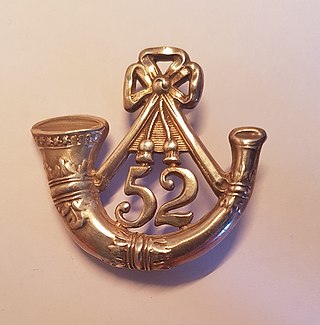
The 52nd (Oxfordshire) Regiment of Foot was a light infantry regiment of the British Army throughout much of the 18th and 19th centuries. The regiment first saw active service during the American War of Independence, and were posted to India during the Anglo-Mysore Wars. During the Napoleonic Wars, the 52nd were part of the Light Division, and were present at most major battles of the Peninsula campaign, becoming one of the most celebrated regiments, described by Sir William Napier as "a regiment never surpassed in arms since arms were first borne by men". They had the largest British battalion at Waterloo, 1815, where they formed part of the final charge against Napoleon's Imperial Guard. They were also involved in various campaigns in India.

The Duke of Cornwall's Light Infantry (DCLI) was a light infantry regiment of the British Army in existence from 1881 to 1959.

The British Army during the American Revolutionary War served for eight years in campaigns fought around the globe. Defeat at the Siege of Yorktown to a combined Franco-American force ultimately led to the loss of the Thirteen Colonies in eastern North America, and the concluding Treaty of Paris deprived Britain of many of the gains achieved in the Seven Years' War. However several victories elsewhere meant that much of the remaining British Empire remained intact.
The 95th Regiment of Foot (Burton's) was an infantry regiment of the British Army.
The 88th Regiment of Foot was an infantry regiment in the British Army from 1779 to 1783, formed during the American Revolutionary War. It was raised in Worcestershire under Colonel Thomas Keating and saw service in Jamaica. It was disbanded in England in 1783 at the end of the war.
104th Regiment of Foot was a regiment of the British Army. The regiment had its origins in the New Brunswick Regiment of Fencible Infantry, a unit of fencibles raised for the defence of the colony of New Brunswick in 1803. Recruits were drawn from across British North America, Scotland, Ireland and existing British Army units. The regiment was formally entered into the establishment in 1806 with a strength of around 650 enlisted men but grew to almost 1,100 by 1808. In 1810 the regiment's officers requested that it join the British Army as a regiment of foot. This request was granted on 13 September 1810 and the unit was renamed the 104th Regiment of Foot.
The Kent Militia was an auxiliary military force in Kent in the South East England. From their formal organisation as Trained Bands in 1558 until their final service as the Special Reserve, the Militia regiments of the county served in home defence in all of Britain's major wars. They also saw active service during the Second Boer War, and trained thousands of reinforcements during World War I. After a shadowy postwar existence they were formally disbanded in 1953.









